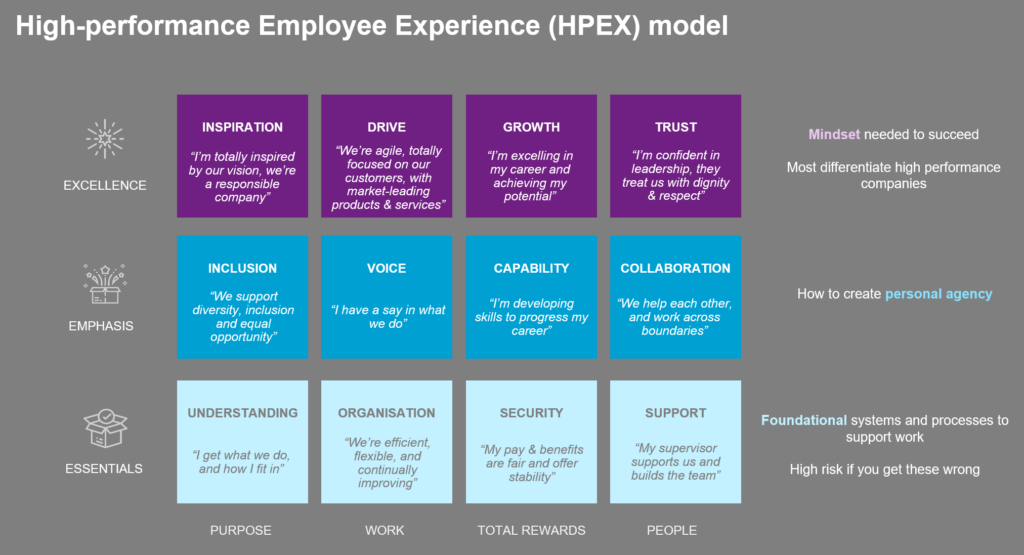Article · 5 minute read
By Hannah Mullaney & Richard Williams – 8th March 2022
The work landscape is rapidly changing. In these times of unparalleled change and uncertainty, it is more important than ever that organizations harness full leadership potential in order to thrive.
In the first three parts of our leadership development series, we looked at the value of empathy, the value of impact, and developing leaders to lead through uncertainty. In our final part, we look at developing leaders to create a high-performance employee experience.
35% of employees report that the stress they experience at work is having a negative impact on them (Champion Health – Workplace Health Report 2022).
One of the ways the work landscape is changing is that more emphasis is (rightly) being placed on the emotional and physical wellbeing of employees, with the simple thinking that happy workers equals a more motivated and engaged workforce, and subsequently higher profits.
A work environment that is communicative and connected promotes happier employees; employees who have the emotional support to grow and improve, maximizing their skillset, leading to greater productivity and retention.
The latest WTW study on High-Performance Employee Experience (HPEX) has revealed a clear link between employee experience and financial performance. HPEX organizations outperform their peers across various key financial metrics, including return on assets and return on equity.
For example, there is a 12% difference in terms of one-year change in gross profit margin between companies with high and low employee experience. The data is compelling and makes a strong argument for ensuring any leadership development activities start to tick off some of what drives a High-Performance Employee Experience.
Take a look at WTW model of HPEX below. Organizations need to ensure that everything in the model is catered for and that their leadership development is picking up on all these points.

To begin with, you can ask yourself the question “Are our leaders ensuring their teams have ‘Understanding’ in terms of ‘Purpose’ and feel supported by them?” Then to build on that, “How do leaders make sure their teams feel included, like they have a voice, like they are utilizing their capability and that they collaborate effectively?”
The next step, to really get to the crux of employee experience, is to ensure that you develop leaders whose teams tick the boxes in terms of ‘Inspiration’, ‘Drive’, ‘Growth’ and ‘Trust’.
More information on the research behind our HPEX model.
Group workshops: Team building sessions where individuals share and explore their personality profiles are an effective way of exploring ‘Collaboration’ and ‘Trust’.
One-to-One Coaching: Many of these themes can be picked up in one-to-one coaching once your cohort and your coaches understand the HPEX model and its power. Of course, bringing in a personality profile such as Wave® can really help get into the nitty gritty of how some individuals might find some areas of HPEX more difficult than others.
HPEX Wheel of Work: We recently created a HPEX ‘Wheel of Work’ (a spin off from the ‘Wheel of Life’ coaching tool) to help an individual work through a particular issue. It provided much-needed clarity regarding where they needed to focus their time and energy. There’s no reason why you couldn’t do something similar with individuals on leadership development programs to help them better understand the model.
Peer to peer projects: Programs that put individuals into groups to work on innovation projects are often met with mixed success. Where we find they work less well is where participants put a lot of time and energy into developing ideas that never get adopted because they don’t hit strategic objectives.
An alternative to this scattergun approach to innovation is to provide a more specific scope and the HPEX model can do just that. You could pair people up to focus on specific tiles; you could form groups that take the lead on a column each, with one group working to drive up ‘Understanding’, one on ‘Inclusion’ and another on ‘Inspiration’, for example.
Accentuate the link between individual goals and company performance – An employee experience that provides a clear connection between individual goals and organizational outcomes and values is key. This can be achieved through targeted messaging and performance reviews that help directly build those connections.
Promote wellbeing resources & events – Promoting available employee resource groups, so employees can connect with colleagues who share similar interests, cultures and views is crucial. Also making sure that team members are aware of wellbeing and mindfulness initiatives (and allowing them the time to attend them) is also important.
In the CIPD’s recent Health & Wellbeing At Work survey, three-quarters of respondents agree/strongly agree that their organization actively promotes good mental wellbeing, a significant increase on previous years; showing that things are heading in the right direction, but that there is still work to be done in this area.
Highlight internal opportunities – Research suggests that when employees hit their six or seven-year anniversary at an organization they start to look outside for new opportunities. Ensuring that people are aware of internal career opportunities that they can explore and providing them with regular opportunities for self-development courses and further qualification can also help aid with retention.
Focus on your line managers – Creating a dedicated space for communicating specifically with managers is a good idea, be it information for onboarding new team members or dealing with HR issues or IT equipment. Make sure that the info is accessible to them in a timely and consistent manner.
In summary, this is a moment in time, more than ever, when leaders need to look at the workplace experience (be that virtual or traditional) and support their employees, as well as understanding the stresses they are under and ensuring that they stay positive against a backdrop of uncertainty and change.
© 2025 Saville Assessment. All rights reserved.